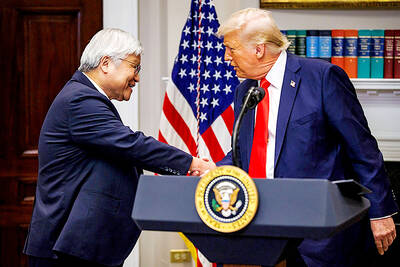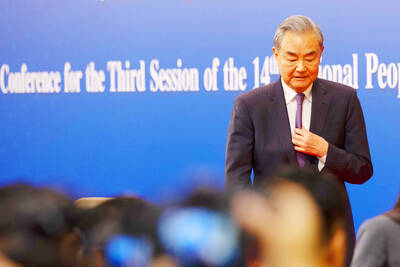Export orders last month increased 1 percent year-on-year to US$50.63 billion, after 14 consecutive months of declines, the Ministry of Economic Affairs said in a report yesterday.
The growth in orders was short of the ministry’s forecast last month of an annual increase of 1.7 to 5.7 percent, but the data suggest a gradual recovery is under way.
The increase came from a low base of comparison a year earlier because of strict COVID-19 control measures in China, the ministry said.

Photo: CNA
It was also due to continued demand related to applications of emerging technologies, such as high-performance computing and artificial intelligence, although falling orders for non-tech goods offset part of the increase, it said.
On a monthly basis, export orders — an indicator of product and component shipments to overseas markets for the following one to three months — decreased 4.2 percent, the ministry said.
Last month’s figure brought combined export orders in the first 11 months of the year down 15.8 percent year-on-year to US$517.23 billion, ministry data showed.
In a recent poll of domestic manufacturers by the ministry, only 15.6 percent of respondents were optimistic that export orders would increase this month from last month, while 58.2 percent said that orders would be flat and 26.3 percent expected them to decline, the report said.
In addition, the diffusion index of export orders — a gauge of manufacturers' expectations on export orders for the following month — fell for the second straight month to 47.8 last month and was below the threshold of 50 which suggests manufacturers' outlook remains weak, it said.
As a result, export orders this month are forecast to decrease 1.2 to 5.2 percent monthly and drop 4.2 to 8 percent annually to US$48 billion to US$50 billion, the ministry said.
For the year as a whole, export orders are expected to total US$565.2 to US$567.2 billion, down 14.9 percent to 15.2 percent from US$666.79 billion last year, it said.
The latest data showed that export orders for information and communications technology products last month grew 10 percent year-on-year, ending nine months of consecutive declines, while orders for electronic goods increased 3.5 percent from a year earlier, after falling for 12 months in a row, as increased shipments of handsets, servers and chips outweighed slowing demand for wafers and printed circuit boards.
Optoelectronics products last month posted a 9.8 percent annual increase as prices of flat panels for TVs were higher than a year earlier and demand for camera lenses continued to increase, the report said.
However, a global economic slowdown and weakening end-market demand continued to pressure firms in non-tech sectors, with export orders for basic metals and machinery goods last month shrinking 0.3 percent and 12.5 percent year-on-year respectively, the report said.
On top of that, increased supply from foreign peers caused export orders for plastics and chemical products last month to post annual declines of 10.2 percent and 7.9 percent respectively, it said.
Last month, orders from Southeast Asia registered the largest annual increase of 69.4 percent, followed by a rise of 8.8 percent in orders from China, including Hong Kong.
Orders from Japan posted the largest annual decline of 29 percent, compared with a drop of 21.1 percent in orders from Europe and 2.4 percent from the US, the report said.

CRITICAL MOVE: TSMC’s plan to invest another US$100 billion in US chipmaking would boost Taiwan’s competitive edge in the global market, the premier said The government would ensure that the most advanced chipmaking technology stays in Taiwan while assisting Taiwan Semiconductor Manufacturing Co (TSMC, 台積電) in investing overseas, the Presidential Office said yesterday. The statement follows a joint announcement by the world’s largest contract chipmaker and US President Donald Trump on Monday that TSMC would invest an additional US$100 billion over the next four years to expand its semiconductor manufacturing operations in the US, which would include construction of three new chip fabrication plants, two advanced packaging facilities, and a research and development center. The government knew about the deal in advance and would assist, Presidential

‘DANGEROUS GAME’: Legislative Yuan budget cuts have already become a point of discussion for Democrats and Republicans in Washington, Elbridge Colby said Taiwan’s fall to China “would be a disaster for American interests” and Taipei must raise defense spending to deter Beijing, US President Donald Trump’s pick to lead Pentagon policy, Elbridge Colby, said on Tuesday during his US Senate confirmation hearing. The nominee for US undersecretary of defense for policy told the Armed Services Committee that Washington needs to motivate Taiwan to avoid a conflict with China and that he is “profoundly disturbed” about its perceived reluctance to raise defense spending closer to 10 percent of GDP. Colby, a China hawk who also served in the Pentagon in Trump’s first team,

SEPARATE: The MAC rebutted Beijing’s claim that Taiwan is China’s province, asserting that UN Resolution 2758 neither mentions Taiwan nor grants the PRC authority over it The “status quo” of democratic Taiwan and autocratic China not belonging to each other has long been recognized by the international community, the Mainland Affairs Council (MAC) said yesterday in its rebuttal of Beijing’s claim that Taiwan can only be represented in the UN as “Taiwan, Province of China.” Chinese Minister of Foreign Affairs Wang Yi (王毅) yesterday at a news conference of the third session at the 14th National People’s Congress said that Taiwan can only be referred to as “Taiwan, Province of China” at the UN. Taiwan is an inseparable part of Chinese territory, which is not only history but

INVESTMENT WATCH: The US activity would not affect the firm’s investment in Taiwan, where 11 production lines would likely be completed this year, C.C. Wei said Investments by Taiwan Semiconductor Manufacturing Co (TSMC, 台積電) in the US should not be a cause for concern, but rather seen as the moment that the company and Taiwan stepped into the global spotlight, President William Lai (賴清德) told a news conference at the Presidential Office in Taipei yesterday alongside TSMC chairman and chief executive officer C.C. Wei (魏哲家). Wei and US President Donald Trump in Washington on Monday announced plans to invest US$100 billion in the US to build three advanced foundries, two packaging plants, and a research and development center, after Trump threatened to slap tariffs on chips made